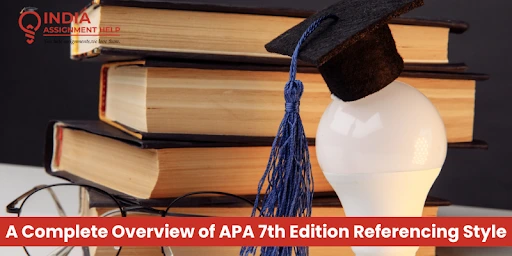An Academic Guide: A Complete Overview of APA 7th Edition Referencing Style

In the world of academic writing, adhering to standards is challenging. To overcome this, enter the American Psychological Association APA 7th edition referencing style, a cornerstone for scholars across various disciplines. This comprehensive guide aims to demystify APA 7th edition, covering critical elements like formatting guidelines, in-text citations, reference list entries, and everyday challenges. From mastering the author-date citation system to navigating the complexities of reference list formatting, this guide equips the writers with the tools required to produce clear, concise, and professional scholarly work. This publication manual is a style guide published by the American Psychological Association, which provides guidelines for writing and formatting research papers, articles, and other types of academic documents.
The APA 7th edition was released in October 2019 and includes updates and revisions to the previous editions (APA 6th edition), aimed at reflecting changes in how research is conducted and disseminated in the digital era. Whether you are a student struggling for academic excellence, a researcher disseminating groundbreaking findings, or an academic seeking to contribute to the body of knowledge, mastering the APA 7th edition referencing style is necessary. With this guide, you will embark on the journey towards academic success, armed with the knowledge and skills to effectively communicate ideas, support arguments, and engage with scholarly discourse rigorously and systematically.
Understanding APA 7th Edition Referencing Style
The APA 7th edition referencing style is built upon a previous edition, with updates and refinements to improve clarity and consistency in citing sources. This follows an author-date citation system where sources are cited within the text using the author's surname and the year of publication. This system lets readers quickly locate the corresponding entry in the reference lists, providing detailed information about each cited source.
Vital Elements of APA 7th Edition Referencing Style
The critical elements of the APA 7th edition referencing style cover the fundamental concepts, formatting guidelines, citation rules, and best practices.
1) Authors
This consists of the author's name in the same order as it appears in the source. Start writing with their surnames, followed by initials, and separate multiple authors with a comma. In the case of more than 20 authors, write the first 19 followed by an ellipsis and provide the last author's name.
2) Publication Date
This includes the publication date inside parentheses after the author's name, immediately following the author's initials. In cases where there is no publication date, use n.d. (no date) instead.
3) Title of the Work
This consists of the work's title, written in sentence case and italicized. Only the first word of the title and proper pronouns are written in capitals for books, articles, and reports. For journal articles, the title of the journal has also been included, and it has been italicized. If the source is an article or chapter within a more significant work, for example, a journal article or book chapter, the title of the more extensive work is italicized and followed by the title of the article or chapter in sentence case and enclosed in quotation marks.
4) Source Information
This field includes the source, such as the title of the journal, book, or website, as well as volumes, issue number, page number, and DOI or URL for online resources for the book. It also includes the name of the publisher and location.
5) DOI or URL
If a source has the DOI, include it in the last part of the reference. If it does not have a DOI, it includes the URL. These URLs are only included for online resources that don’t have a DOI.
6) Access date
For those online sources that change after a particular time, like websites, it includes the date you accessed the source. This component is optional and usually included at the end of the reference entry in the format of Retrieved Month, Day, Year, and then from and the URL.
7) Edition and Volume Number
This component may or may not be applicable. This includes the edition number for the work and the volume. This is present inside the parenthesis after the title of the work.
8) Page Number
This component is applicable for direct quotations, paraphrases, and summaries. This component helps the reader find the specific information that is referred to within the source.
Common Challenges that Writers Face in Drafting APA 7th Referencing Style Assignments and Their Solutions
1) Multiple Authors
Challenge: It will be difficult to properly format the names in the reference entry when there are more than three authors.
Solution: Use et al. after the first author's name when citing a source with four or more authors. This helps in ensuring consistency in formatting all the references.
2) Missing Information
Challenge: Sometimes, the source may miss some of the critical information, like the publication date, page number, or DOI/URL.
Solution: We need to make a reasonable effort to locate the missing information. If certain information is not present, include as much information as possible and use it for no harm. Make a stable URL or archive link if it is an online source.
3) Electronic Source
Challenge: Electronic sources such as websites, online articles, and social media posts may not always conform to traditional citation formats.
Solution: Follow APA guidelines for citing to overcome the challenge of electronic sources. It includes the maximum possible information, like the author's name, publication date, title of the article or page, URL, and access date.
4) Formatting Errors
Challenge: Incorrect formatting of reference entities can lead to confusion or lower the quality of the paper. It may include improper indentation or inconsistent use of italics.
Solutions: To overcome this challenge, you must review the APA manual or online resource for guidance on proper formatting. Utilizing citation management tools like Zotero or EndNote to generate correctly formatted references and citations can help.
5) Different Types of Resources
Challenge: Handling diverse sources such as books, journals, conference papers, and online videos may pose.
Solution: To handle this challenge, consult the APA manual or the best online guides for specific instructions on citing the different types of sources. Pay attention to capitalization, punctuation, and italicization for each source type.
6) Changes in APA Guidelines
Challenge: Learning the updates and changes in APA guidelines can be challenging.
Solution: Students can solve this by regularly connecting with official APA sources. Also, attending workshops and keeping aligned with the latest APA standards can help.
7) Plagiarisms
Challenge: Plagiarism may occur due to the non-citation of resources properly. This happens if paraphrasing is not done effectively.
Solution: Students can meet this by using APA guidelines on paraphrasing and citing the sources. Using attribute ideas, data, and quotes from their original authors can be a solution. They can also use quotation marks for direct quotes and information while providing proper citations.
8) Foreign Language Sources
Challenge: Citing sources in languages other than English may cause difficulties in alphabetization and translation.
Solution: To overcome this, follow APA guidelines for citing non-English sources and provide translations for titles and relevant information.
Conclusion
In conclusion, mastering the key elements of the APA 7th edition referencing style is essential for academic writers to uphold scholarly integrity, facilitate knowledge dissemination, and ensure clarity and consistency in their research papers. This web blog explores the fundamental components of APA 7th edition referencing style, including authorship publication date, title of work, source information, DOI or URL, access date, edition and volume number, page numbers, and additional details. Electronic sources, in particular, require careful attention due to their dynamic nature and varied formats. Writers must adapt citation formats accordingly and ensure the accuracy and completeness of reference entries.
Moreover, mastering the APA 7th edition referencing style is crucial for avoiding plagiarism. A severe ethical violation that undermines academic integrity and erodes the credibility of scholarly work. Writers must diligently attribute ideas, data, and quotes to their sources. Also, employ proper paraphrasing techniques and use quotation marks for direct quotes. Seek out the writers from the India assignment help platform, who are skilled and knowledgeable in completing APA formatting and referencing. They can also help students draft assignments using APA 7th referencing styles.
FAQs
Q.1 How is the APA 7th edition valuable in academic writing?
Ans:- The APA 7th edition referencing style is a cornerstone of academic writing. They are providing a standardized framework for citing and referencing sources across disciplines. By familiarizing themselves with its essential elements, understanding common challenges, and implementing practical solutions, writers can confidently and precisely navigate the complexities of referencing.
Q.2 Why is learning the APA 7th edition useful?
Ans:- APA 7th edition guidelines not only enhance the quality and credibility of scholarly work but also contribute to advancing knowledge and the integrity of the academic enterprise.
Q.3 Why is India assignment help the best for academic help?
Ans:- India Assignment is a platform with writers who can define and draft any complex concept in the required referencing style, like APA, MLA, HARWARD, CHICAGO, etc.
Q.4 How skilled are India assignment help writers?
Ans:- The skilled writers at India Assignment help the platform stay updated with changes in the academic world, like updating the APA referencing style to APA 7. APA guidelines, transitioning from previous editions to the 7th edition, and employing citation management tools help writers maintain compliance with the latest standards and streamline the citation process.





